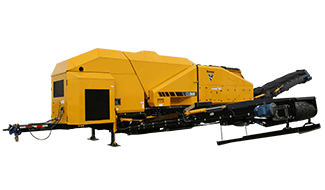When contaminants get mixed in with your organic material, what do you do? After screening, what do you do with your contaminated overs? Pile it off to the side, take it to the landfill or reintroduce it to the next windrow?
If you find yourself in that situation, a contaminant separator can help by removing that contaminated material, freeing up more clean, organic material for you to process.
“Organic recycling is important to help keep materials that can be used to make compost, soils and mulch out of landfills,” says Jay Van Roekel, product manager for Vermeer Environmental. “The challenge most recycling facilities face is separating nonorganic waste and other materials that do not break down from their end products. Plastics and other materials are often introduced early into the recycling process, and there have not been effective ways to remove them afterward.”
The CS3500 contaminant separator does exactly that, removing contaminants from organic material to help maximize the end product.
Let’s walk through each stage of the process to examine how the contaminants are removed.
Unique 5-stage separation process
The CS3500 uses a unique 5-stage separation process to remove the contaminants.
It combines several methods of removal, including the grizzly screen, infeed vacuum, vibrating table with air manifold, discharge vacuum and optional magnetic discharge pulley. The material can be fed directly into the separator from any type of screener with a discharge height of at least 9 ft (3 m).
Stage 1: Infeed shaker and grizzly
In the first stage, the infeed shaker and grizzly bars help spread the material out and separate larger materials, like rocks or other contaminants.
Stage 2: Infeed belt vacuum
As material falls onto the main shaker table, the infeed belt vacuum pulls light plastics away from the clean organics. The CS3500 has been designed to pull plastic and other contaminants out at each stage of the process.
Stage 3: Shaker table and air manifold
After that, the shaker table agitates the material to bring both light and heavy plastics to the top of the burden pile. The air manifold has adjustable air flow that removes dislodged contaminants from the shaker table and blows it to the trash conveyor. You can directly access the shaker table by opening up the air manifold, maximizing serviceability and minimizing maintenance time.
Stage 4: Discharge vacuum
While the contaminants are taken to the trash conveyor, the leftover organics travel from the shaker table to the discharge conveyor. As it falls to the discharge conveyor, a second vacuum pulls out remaining plastics. It also allows the organics to pass through to the conveyor and out the side of the machine.
Stage 5: Optional magnetic head pulley
The final stage of separation happens on the organic discharge conveyor. An optional magnetic pulley removes metal that may have been missed in the earlier stages.
The CS3500 is equipped with two discharge conveyors, one designated for waste and the other for organics. The waste-collecting conveyor is powered by a 5-hp (4-kW) electric motor at a length of 27 ft (8.2 m) and has an operating height between 4.5 ft to 15.5 ft (1.4 m to 4.7 m), located at the rear of the machine. This conveyor catches sorted material from the grizzly, vacuum number one, main shaker table and vacuum number two. The wide range of the operating height allows the machine to be able to discharge into a pile, truck or dumpster, giving you several different avenues for disposal. This conveyor is also covered, which helps prevent the loss of separated contaminants from wind.
If waste gets mixed in with your organic material on a regular basis, and you’d rather save that material than let it sit in a waste pile, the CS3500 contaminant separator provides you with an opportunity that can help maximize your end product, whether it’s mulch, compost or recyclable materials.
For more information on the CS3500, reach out to your local Vermeer dealer.
Vermeer Corporation reserves the right to make changes in engineering, design and specifications; add improvements; or discontinue manufacturing at any time without notice or obligation. Equipment shown is for illustrative purposes only and may display optional accessories or components specific to their global region. Please contact your local Vermeer dealer for more information on machine specifications.
Vermeer, the Vermeer logo and Equipped to Do More are trademarks of Vermeer Manufacturing Company in the U.S. and/or other countries. © 2023 Vermeer Corporation. All Rights Reserved.
